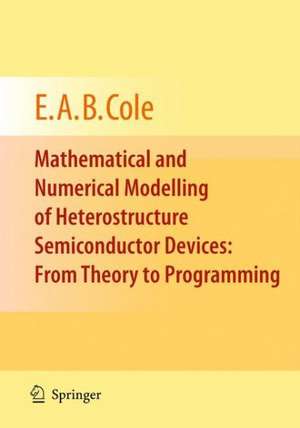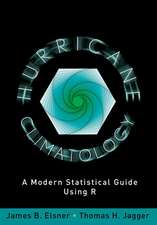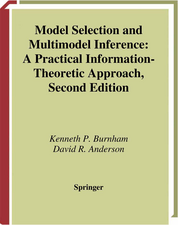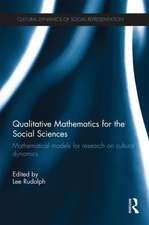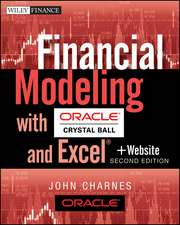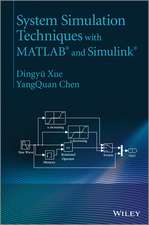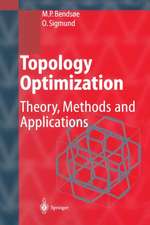Mathematical and Numerical Modelling of Heterostructure Semiconductor Devices: From Theory to Programming
Autor E.A.B. Coleen Limba Engleză Paperback – 14 dec 2009
Preț: 395.47 lei
Nou
Puncte Express: 593
Preț estimativ în valută:
75.70€ • 82.25$ • 63.63£
75.70€ • 82.25$ • 63.63£
Carte tipărită la comandă
Livrare economică 21 aprilie-05 mai
Preluare comenzi: 021 569.72.76
Specificații
ISBN-13: 9781848829367
ISBN-10: 1848829361
Pagini: 424
Ilustrații: XV, 406 p. 40 illus.
Dimensiuni: 155 x 235 x 22 mm
Greutate: 0.59 kg
Ediția:2009
Editura: SPRINGER LONDON
Colecția Springer
Locul publicării:London, United Kingdom
ISBN-10: 1848829361
Pagini: 424
Ilustrații: XV, 406 p. 40 illus.
Dimensiuni: 155 x 235 x 22 mm
Greutate: 0.59 kg
Ediția:2009
Editura: SPRINGER LONDON
Colecția Springer
Locul publicării:London, United Kingdom
Public țintă
ResearchCuprins
Overview and physical equations.- Overview of device modelling.- Quantum mechanics.- Equilibrium thermodynamics and statistical mechanics.- Density of states and applications—1.- Density of states and applications—2.- The transport equations and the device equations.- Mathematical and numerical methods.- Basic approximation and numerical methods.- Fermi and associated integrals.- The upwinding method.- Solution of equations: the Newton and reduced method.- Solution of equations: the phaseplane method.- Solution of equations: the multigrid method.- Approximate and numerical solutions of the Schrödinger equation.- Genetic algorithms and simulated annealing.- Grid generation.
Recenzii
From the reviews:
“The book covers a wide spectrum of topics that are fundamental for modelling and simulation of semiconductor electron devices … . It is addressed to undergraduate and graduate students in mathematics and electrical engineering as well as researchers who would like to get different perspectives on the subject. … The monograph is self-contained since a standard background in calculus is enough to read it. This is surely a good textbook for Ph.D. students in applied mathematics.” (Vittorio Romano, Mathematical Reviews, Issue 2011 e)
“This well-written book involves the basic physical theory of semiconductor device modelling and the numerical methods to solve the corresponding equations. … Problems are formulated to improve the skill of the reader … . In order to support the reader, in the implementation of the methods, some simple codes written in C++ are included. … A great advantage of this monograph consists in the presentation of the whole cycle of semiconductor device modelling … .” (Georg Hebermehl, Zentralblatt MATH, Vol. 1252, 2012)
“The book covers a wide spectrum of topics that are fundamental for modelling and simulation of semiconductor electron devices … . It is addressed to undergraduate and graduate students in mathematics and electrical engineering as well as researchers who would like to get different perspectives on the subject. … The monograph is self-contained since a standard background in calculus is enough to read it. This is surely a good textbook for Ph.D. students in applied mathematics.” (Vittorio Romano, Mathematical Reviews, Issue 2011 e)
“This well-written book involves the basic physical theory of semiconductor device modelling and the numerical methods to solve the corresponding equations. … Problems are formulated to improve the skill of the reader … . In order to support the reader, in the implementation of the methods, some simple codes written in C++ are included. … A great advantage of this monograph consists in the presentation of the whole cycle of semiconductor device modelling … .” (Georg Hebermehl, Zentralblatt MATH, Vol. 1252, 2012)
Textul de pe ultima copertă
The commercial development of novel semiconductor devices requires that their properties be examined as thoroughly and rapidly as possible. These properties are investigated by obtaining numerical solutions of the highly nonlinear coupled set of equations which govern their behaviour. In particular, the existence of interfaces between different material layers in heterostructures means that quantum solutions must be found in the quantum wells which are formed at these interfaces.
This book presents some of the mathematical and numerical techniques associated with the investigation. It begins with introductions to quantum and statistical mechanics. Later chapters then cover finite differences; multigrids; upwinding techniques; simulated annealing; mesh generation; and the reading of computer code in C++; these chapters are self-contained, and do not rely on the reader having met these topics before. The author explains how the methods can be adapted to the specific needs of device modelling, the advantages and disadvantages of each method, the pitfalls to avoid, and practical hints and tips for successful implementation. Sections of computer code are included to illustrate the methods used.
Written for anyone who is interested in learning about, or refreshing their knowledge of, some of the basic mathematical and numerical methods involved in device modelling, this book is suitable for advanced undergraduate and graduate students, lecturers and researchers working in the fields of electrical engineering and semiconductor device physics, and for students of other mathematical and physical disciplines starting out in device modelling.
This book presents some of the mathematical and numerical techniques associated with the investigation. It begins with introductions to quantum and statistical mechanics. Later chapters then cover finite differences; multigrids; upwinding techniques; simulated annealing; mesh generation; and the reading of computer code in C++; these chapters are self-contained, and do not rely on the reader having met these topics before. The author explains how the methods can be adapted to the specific needs of device modelling, the advantages and disadvantages of each method, the pitfalls to avoid, and practical hints and tips for successful implementation. Sections of computer code are included to illustrate the methods used.
Written for anyone who is interested in learning about, or refreshing their knowledge of, some of the basic mathematical and numerical methods involved in device modelling, this book is suitable for advanced undergraduate and graduate students, lecturers and researchers working in the fields of electrical engineering and semiconductor device physics, and for students of other mathematical and physical disciplines starting out in device modelling.
Caracteristici
Entirely self-contained: the basic ideas of quantum mechanics and statistical mechanices are introduced and developed and numerical techniques, such as multigrids and genetic computing, are explained in a manner that is comprehensible to readers who have had no previous contact with these subjects Case studies show how the numerical techniques can be tailored to the specific problems of device modelling Includes sections of computer code, written in C++, and written in a simple and transparent way so that the reader can re-write it in his or her own favourite programming language Includes supplementary material: sn.pub/extras
